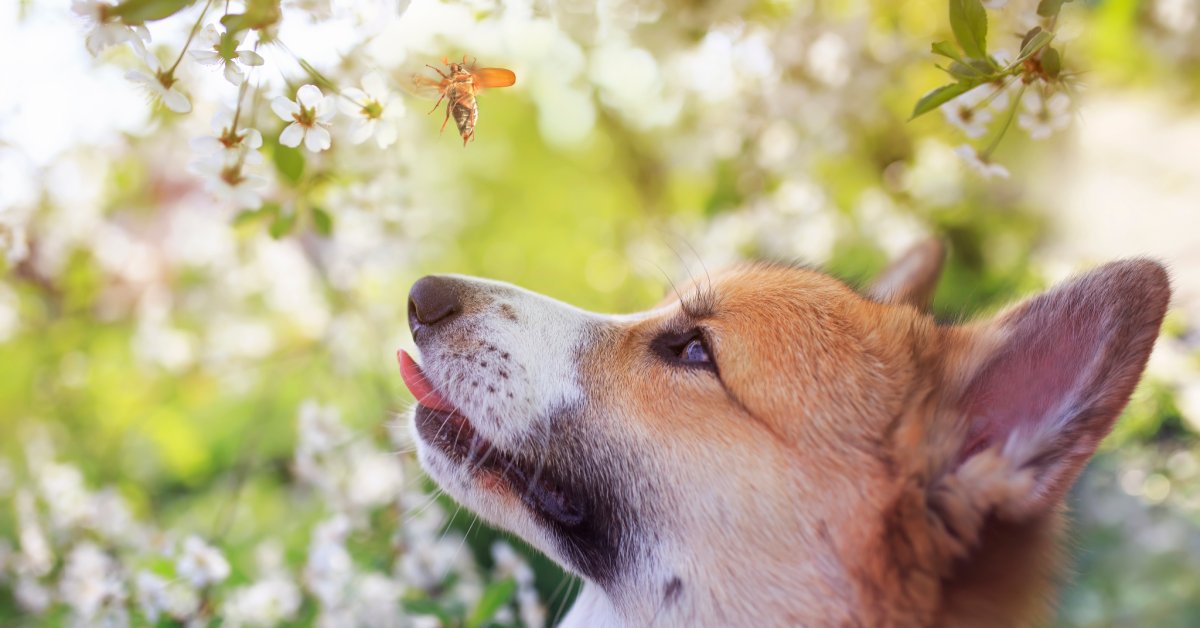In the warmer months, frolics in the park and spending time outdoors are a great source of joy for you and your dog. Unfortunately, being outdoors in the spring and summertime bring with them some unique hazards, including bee stings.
Dogs are not as wary of bees as we humans are, so their curiosity can sometimes lead to one or multiple bee stings. Dogs may get stung if they chase after a bee, or accidentally stumble on a bee hive. A bee can sting anywhere on your dog’s body, even your dog’s face.
In this article, you’ll learn how to:
- Apply first aid for minor bee stings
- Recognize signs of bee sting allergic directions
- Understand when an emergency vet visit is required
What is a dog bee sting and why does it happen?
When bees feel threatened or endangered, they respond with a sharp sting that releases venom into the skin. The sting is a defense mechanism meant to scare off any attackers who might put the hive in danger. While your dog’s curious sniffing is really nothing for concern, their paws or snouts intruding into bee territory can be seen as a threat.
How do I know if my dog has been stung by a bee?
There are some classic signs to look out for to determine whether your dog has been stung by a bee. If you are outdoors in an area where you have noticed bees, and your dog shows any of the following signs, it’s likely that they have been stung.
- Limping/laying off one or more paws
- Yelping or whining
- Evidence of a bee stinger in their skin
- Biting, nibbling, or licking at a specific spot (likely where the stinger went in)
- Red or swollen skin
How to apply first aid for dog bee stings
Luckily, most bee stings are relatively harmless with proper at-home treatment. These are the steps you should take to treat your dog’s bee sting at home.
Step 1: Remove the bee stinger
If the bee stinger is lodged in your dog’s skin, you need to carefully remove it. Avoid the temptation to get tweezers involved, as this could cause more venom from the stinger to be released into your dog’s skin.
Instead, take a flat, hard object (a credit card is ideal) to scrape along the surface of your dog’s skin and gently remove the stinger.
Step 2: Clean the wound
Using a damp towel, slowly and gently clean the area around the bee sting.
Step 3: Apply a cold compress
Take an ice pack wrapped in a towel, or simply a towel doused in cold water and hold this to the affected area. The cold will provide pain relief for your dog and help ease any swelling. For further pain reduction, apply a thick paste of baking soda and water to the sting site. This is said to help counteract the acidity of bee venom.
Step 4: Monitor for any signs of an allergic reaction
This is the most important step. While most dogs will be okay and recover quickly after a bee sting, some dogs may have an allergic reaction. Reactions typically range from mild to extremely severe form known as anaphylaxis. These are the symptoms to look out for.
Signs of a mild to moderate allergic reaction
- Redness
- Pronounced or noticeable swelling
- Pain when the area is touched
- Hives or welts (pronounced, itchy red bumps)
- Drooling
- Yelping and/or whining
- Licking, chewing, pawing, or scratching at the sting area
Signs of a severe allergic reaction, or anaphylaxis
A bee sting can quickly become a life-threatening emergency if you see any of these signs:
- Difficulty breathing
- Drooling
- Swelling in areas that could restrict airways or affect breathing, like the mouth or throat
- Swelling of the eyes or ears
- Lethargy and weakness
- Disorientation
- Vomiting
- Diarrhea
- Fits or seizures
The most severe form of an allergic reaction is known as anaphylaxis or anaphylactic shock. Anaphylaxis is the body’s way of responding to an interaction with a foreign substance or allergen. It’s dangerous because the body overreacts to the allergen, resulting in symptoms like red hives or wheals, difficulty breathing, and sudden vomiting.
When to seek veterinary care for a dog bee sting
If you suspect your dog is having a severe reaction to their bee sting, this is a medical emergency. You need to head to your nearest emergency veterinary clinic as fast as possible. The faster you can act, the better your dog’s chances of recovery.
Signs of infection after a bee sting
It’s possible that your dog might get an infection from the wound the bee’s stinger left in their skin. Keeping it clean and dry should prevent this, but if you notice it’s not healing well or the redness and swelling are getting worse, you should see your vet.
Signs of discomfort or pain after a bee sting
If your pet continues to show discomfort or pain from the sting site, it may be prudent to call your vet and get their expert opinion. They can suggest methods for pain relief or let you know if more serious treatment is needed.
Bee stings are just one unexpected accident your dog may face over their lifetime! Be prepared to help your pet get the best treatment for unexpected stings, bites, and wounds with extensive accident & illness coverage from Pumpkin.
FAQS
How do I know if my dog is allergic to bees?
The first time your dog is stung by a bee, you will get a good sense of whether they are allergic or not based on their body’s reaction. Unfortunately, unless you’re watching your dog like a hawk, it might be hard to say which type of bee stung your dog. Plus, if there’s no stinger left behind, it may be hard to determine whether it was a bee at all!
A severe allergic reaction usually won’t happen until the second time your dog has been stung. This is because the first time will introduce the allergen – the bee venom – to your dog’s immune system and after that, they may develop an allergy to the venom that reveals itself the next time they get stung.
The best thing to do is keep a close eye on your dog whenever there is a risk of a bee sting.
How long after a bee sting will my dog have a reaction?
It’s tough to give an exact estimate. Your dog may show a reaction in the first 10-30 minutes or their reaction could be delayed until several hours later. If you know your dog has been stung, it’s wise to keep an eye on them for a few hours after the time of the sting.
Can I give my dog Benadryl for a bee sting?
No, you should not give your dog any kind of medication, like diphenhydramines, until you have sought your vet’s opinion. Benadryl is the brand name for one type of diphenhydramine commonly used as a human OTC medication for allergic reactions.
Your vet may advise you to give your dog a dose of an oral antihistamine to assist with a bee sting. You should always seek your vet’s recommendation before taking any action, as they can advise on the type of antihistamine and dose that is suitable for your dog’s breed and size.
Should I take my dog to the emergency vet for a bee sting?
If your dog is showing signs of a severe allergic reaction, you need to treat this as a medical emergency and go to your nearest vet right away.
Are there other insect stings I should be aware of?
There are many other pesky insect bites and stings that can cause problems for your dog, including things like:
- Ant bites
- Wasp stings
- Flea and tick bites
- Hornet stings
- Bites from flies
- Mites
Will my dog be okay after a bee sting?
In most cases, your dog will only have a mild reaction and be just fine after a bee sting. It will be uncomfortable for them for a little while, but they’ll be right as rain in no time.
Severe allergic reactions to bee stings are medical emergencies and require immediate veterinary treatment. If you think this is happening to your dog, act as fast as you can!
Final thoughts on dog bee stings
For your dog’s health and safety, it pays to know exactly how to react if a bee sting does produce a severe allergic reaction in your dog. That said, dog bee stings don’t happen as often as you might think, and luckily a bee sting is only a small nuisance for your dog in the majority of cases. The fear of bee stings should never deter you or your dog from enjoying the fresh outdoors!




